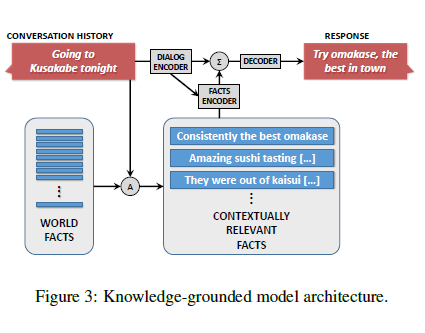A Knowledge-Grounded Neural Conversation Model
A Knowledge-Grounded Neural Conversation Model
Introduction
Grounded Response Generation
The main challenge in fully data-driven conversation models is that there is no dataset that contains discussions of every entry in non-conversational data sources such as Wikipedia and Goodreads. Thus, data driven conversation models are bound to respond evasively concerning inputs that are poorly represented in the training dataset. Even if a comprehensive dataset existed, its sheer size would cause problems in modelling such as redundancy. The knowledge-grounded approach aims to avoid redundancy and generalize from existing information in order to generate appropriate responses to entities that are not part of the conversational training data.

The set-up for a knowledge-grounded model is as follows (See Figure 3):
1. Available is a large collection of raw text entries (denoted Word facts) e.g. Wikipedia
2. The focus of a given conversation history or source text S is identified using key matching words and the focus is used to form a query that retrieves contextually relevant “facts” F.
3. Finally both F and S are fed into a neural architecture that contains distinct encoders.
The system is trained using multi-task learning which contains two types of tasks:
A The model is trained with only conversation history (S) and the Response (R).
B The model is trained with information/“facts” (F), S and R.
This method of training has advantages including allowing the pre-training of conversation-only datasets and flexibility to expose different kinds of conversational data in the two tasks.
Dialog Encoder and Decoder
The dialog encoder and decoder are both recurrent neural networks (RNN). The encoder turns a variable-length input string into a fixed-length vector representation. The decoder turns the vector representation back into a variable-length output string.
Facts encoder
The Facts Encoder uses an associative memory for modeling the “facts” relevant to the particular entity mentioned in a conversation. It retrieves and weights these “facts” based on the user input and conversation history and generates an answer. The RNN encoder gives a rich representation for a source sentence.
Recurrent Neural Network
The hidden state of the RNN is initialized with weights which are a summation of input sentence(as vector) and the external facts(as vector), to predict the response sentence R word by word. Alternatives to summing up facts and dialog encoding were explored, however summation seemed to yield the best results.
Datasets
Experimental Setup
Results
In order to assess the effectiveness of the multi-tasking neural conversation model over the SEQ2SEQ model, the perplexity, BLEU scores, lexical diversity, appropriateness, and informativeness of the output datum were evaluated. Perplexity is measured by how well the model is able to evaluate the input data. Lexical diversity is the ratio of unique words to the total number of words in the input data. The BLEU score measures the quality of the encoded text. Appropriateness is how fitting the output response is to the input data. Informativeness is how useful and actionable the output response is in terms of the input data. Perplexity, lexical diversity, and BLEU scores were all carried out automatically, whereas appropriateness and informativeness were analyzed by human judges.
In terms of perplexity, the MTASK and SEQ2SEQ models all performed almost equally as low when using general data. When using grounded data, the perplexity of all the models increase, however the increase in perplexity for MTASK and MTASK-R are lower than that for SEQ2SEQ and SEQ2SEQ-S. This suggests that the MTASK models perform better than the SEQ2SEQ models in terms of evaluating the inputs. In terms of BLEU scores, MTASK-R produces a high value of 1.08, indicating that it greatly outperforms the other MTASK and SEQ2SEQ models. In terms of lexical diversity, MTASK-RF has the highest percentage of word diversity among all the models. In terms of appropriateness, the performance of the MTASK models were only slightly better than the SEQ2SEQ models. In terms of informativeness, the MTASK-R model generally outperforms the other MTASK and SEQ2SEQ models. It was also discovered that MTASK-F is highly informative but struggles with appropriateness of the conversation. On the other hand, MTASK-R is able to produce appropriate responses but is not significantly better in terms of informativeness.
Discussion and Conclusion
Generally, the responses from the MTASK models were more effective than the SEQ2SEQ models. The MTASK models are able to combine ground data with the general data to generate informative, appropriate, and useful responses. However, the MTASK models tend to repeat elements of ground data word-for-word in its response, which requires improvement.